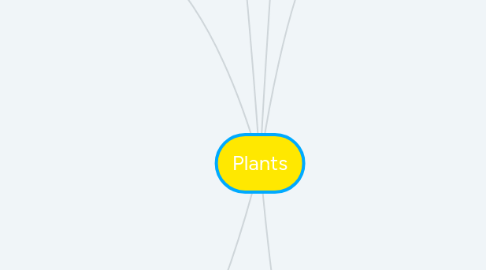
1. Plant hormones
1.1. Auxins
1.1.1. Allows plants to bend towards the light (phototropism)
1.1.2. Synthesized at stem tips, travels downward
1.2. Cytokinins
1.2.1. Counters senescence, produced in the roots (forming roots or shoots)
1.2.2. Works with ethylene to cause shedding of leaves/flowers
1.3. Gibberellins
1.3.1. Required for plant to germinate, promote elongation of internodes
1.4. Ethylene
1.4.1. Ripens fruits, diffuses out of cells, prevents lead expansion
1.5. Abscisic acid
1.5.1. Signals dehydration, in chloroplasts, causes leaves to close up to reduce water loss
2. Response to environmental stimuli
2.1. Plant responses
2.1.1. Ability to detect change and respond is called sensitivity
2.1.2. Response is a form of defence
2.1.3. Plants adapt to new situations by modifying their growth and their hormones
2.2. Plant hormones
2.2.1. Hormone: chemical produced in one part of an organism transported to other tissues (control growth)
2.2.2. Hormones are produced in response to a stimuli to cuase response
2.2.3. They are produced in the meristems (tips) of the plant
2.2.4. Transported through the xylem and phloem
2.3. Nastic response: a plants movement in response to stimulus that is not associated with it's direction
2.4. Tropism: plant growth response to external stimulus coming from one direction in the environment
2.4.1. Phototropism: growth response of a stem towards light so it can receive the maximum amount for photosynthesis
2.4.1.1. Caused by unequal distribution of auxins (less auxins produced on the side of the plant towards light)
2.4.2. Gravitropism: plants natural growth response to the effects of gravity
2.4.2.1. Roots grow towards gravitational pull (stem against), and plant returns to upward position as a response
2.4.3. Thigmotropism: growth of a plant in response to contact
2.4.3.1. Winding effect where plants can grab onto things
3. Succession
3.1. External factors that affect plant distribution
3.1.1. Regional: Annual min temperature Average precipitation Length of growing season Geographic barriers (ex: oceans)
3.1.2. Local: Light levels Soil quality Snow cover Competition Pollinators Diseases Herbivores Fire Wind levels
3.2. Ecological succession: changes that occur in ecosystems as one community replaces another overtime
3.2.1. Plants serve ecosystems by adding nutrients to the soil, draining and filtering water, providing food and water
3.2.2. Climax community is the final stage (ex: mature oak forest)
3.3. Primary succession: establishes a community in an area of exposed rock (no topsoil)
3.3.1. Plants compete for light and space to survive
3.4. Secondary succession: recolonization of an area after an ecological disturbance (soil still in tact)
3.4.1. Seeds and roots remain, some germinate after a fire
3.5. Ecological disturbances
3.5.1. Frequent and important; provide opportunities for plant growth
3.5.2. The greater the plant diversity, the more resilient the ecosystem is
3.5.3. Ex: fallen trees open spaces in the canopy and allow shade intolerant plants the opportunity to be established
4. Introduction to plants
4.1. Plants can find their own food, show active responses to nutrients, predators and environment
4.2. Examples of plant behaviours
4.2.1. Roots are able to grow and look for food
4.2.2. Plants are able to grow towards the sun
4.2.3. Roots are able to accelerate growth to travel to patches of nutrients and slow down when passing them to maximize consumption
4.3. Obligate parasites: lives entirely off of a host plant, has 72 hours to find host or die
5. Plants classification
5.1. Classification method for plants (similar to dichotomous key)
5.1.1. Non-Vascular
5.1.2. Vascular
5.1.2.1. Seedless
5.1.2.2. Seeded
5.1.2.2.1. Gymnosperm
5.1.2.2.2. Angiosperm
5.2. Non-Vascular: lack specialized tissue to transport water and nutrients
5.2.1. Short, no vessel system, no true leaves, roots, or stems, depend on osmosis and diffussion for nutrients, need to grow close to water
5.2.2. Ex: moss
5.3. Vascular: specialized tissue to help transport water and nutrients
5.3.1. Tall, most plants are vascular, have roots, leaves and stems, ability to leave away from major water sources
5.3.2. Ex: Flowers, trees
5.4. Seedless: do not have seeds spread by windblown spores. Tend to live in moist areas
5.4.1. Ex: ferns
5.5. Seeded: contain an embryo surrounded by a seed coat. Inside the seed is nutrients that help feed as it grows
5.5.1. Ex: tree, flower
5.6. Gymnosperm: long thin needles, cone bearing, do not produce seeds or fruit, requires pollen, generally trees, widespread root systems, harsh environments
5.6.1. Ex: pine trees
5.7. Angiosperms: flowering or fruit bearing plants, fruits disperse seeds, play a role in feeding people, most abundant plant form on Earth
5.7.1. Ex: flowers, grass
5.8. Monocot: has one cotyledon
5.9. Dicot: has two cotyledons
5.9.1. Cotyledon: embryonic tissue that will form the first leaves of a plant
6. Plant adaptations
6.1. Adaptations to the arctic
6.1.1. Mosses, lichens, trees and shrubs live here
6.1.2. Roots are shorter and plants are shorter
6.1.3. Built in antifreeze to withstand cold
6.1.4. Faster lifecycle to take advantage of limited sunlight
6.2. Adaptations to the desert
6.2.1. Long, shallow root systems
6.2.2. Cacti live here
6.2.3. Able to store large quantities of water because of the waxy skin to reduce water loss
6.2.4. Have accordion pleats to allow expansion
6.2.5. Spines prevent predators from getting to their water supply
6.3. Adaptations to the rainforest
6.3.1. Good competition for pollinators by use of scents and flower structures
6.3.2. Competition for sunlight results in plants that grow on trees with trailing roots such as orchids
6.3.3. Some don't obtain enough nutrients from the soil and consume insects instead like the Venus fly trap
